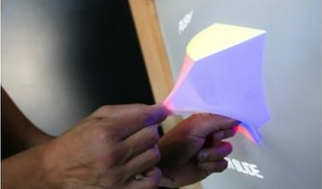
This breakthrough in user interaction with tech allows us to handle objects, data, in a completely new way. A surgeon, for instance, will be able to work on a virtual brain physically, with the full tactile experience, before performing a real-life operation. Designers and artists using physical proxies such as clay can mould and remould objects and store them in the computer as they work. GHOST researchers are also working with deformable interfaces such as pads and sponges for musicians to flex to control timbre, speed and other parameters in electronic music.
Prototypes: ‘Emerge’ is one which allows data in bar charts to be pulled out of the screen by fingertips. The information, whether it’s election results or rainfall patterns, can then be re-ordered and broken down by column, row or individually, in order to visualise it better.
‘Morphees’, flexible mobile devices with lycra or alloy displays which bend and stretch according to use. These can change shape automatically to form screens to shield your fingers when you type in a pincode, for example, or to move the display to the twists and turns of a game. And such devices can be enlarged in the hand to examine data closer and shrunk again for storing away in a case or pocket.
One of the GHOST partners, the University of Bristol has a startup UltraHaptics, to develop tech that uses ultrasound to create feeling in mid-air. ‘Displays which change shape as you are using them are probably only 5 yrs off now. If you want your smartphone to project the landscape of a terrain 20 or 30 cm out of the display, that’s a little further off – but we’re working on it!’ http://cordis.europa.eu/result/rcn/167038_en.html

See the MBot Cube Desktop 3D Printer For the office, school and home.
Simple open design. Pick the body color that suits you.
Clean and waste-free building process.
Compact and portable – you can move it to the power supply without difficulty.
You can print from SD card, instead of PC.








Recent Comments